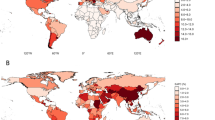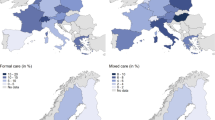Abstract
Background Measures of health expectancy such as Disability Free Life Expectancy are used to evaluate and compare regional/national health statuses. These indicators are useful for understanding changes in the health status and defining health policies and decisions on the provision of services because provide useful information on possible areas needing interventions and burden of care to health systems. Methods Two databases have been used for the analysis: the Italian Health Interview Survey and the European Community Household Panel. The data were analyzed by gender and geographic area. DFLE was calculated by the Sullivan method. Results In 2005 in Italy women have a longer life expectancy than men: 84 and 78 years, respectively. But if we consider life without disability in Italy the male disadvantage reduces: men live 85% of their years without disability, women only 75%. Geographic differences do exist because Disability Free Life Expectancy is longer in Northern and in Central regions; shorter in the South. At a European level similar data can be found: on average women live longer but they have a longer time of life with disability. Conclusion In Italy women live longer but have a worse quality of health than men; in the South there is a worse quality of health. Similar findings can be identified at a European level. The Italian situation with the highest percentage of DFLE at 65 out of the total LE at 65 and one of the longest LE witnesses ageing is not necessarily associated to a worsening of health.


Similar content being viewed by others
References
Bebbington, A., & Bajekal, M. (2003). Sub-national variations health expectancy. In J. M. Robine, C. Jagger, C. D. Mathers, E. M. Crimmins, & R. M. Suzman (Eds.), Determining health expectancy (pp. 127–147). Chichester, England: Wiley.
Blacklow, R. S. (2007). Actuarially speaking: An overview of life expectancy. What can we anticipate? [Journal: Conference Paper] American Journal of Clinical Nutrition, 86(5), 1560S–1562S. (Date of Publication: 01 Nov 2007).
Bobak, M., Kristenson, M., Pikhart, H., & Marmot, M. (2004). Life span and disability: A cross sectional comparison of Russian and Swedish community based data. British Medical Journal, 329(7469), 767. doi:10.1136/bmj.38202.667130.55. Epub 2004 Sep 17.
Cambois, E., & Robine, J. M. (2001). Contribution of disability-free life expectancy indicators to the study of social inequities in health. Sante Publique, 13(2), 137–149.
Crimmins, E. M., & Cambois, E. (2003). Social inequalities in health expectancy. In J. M. Robine, C. Jagger, C. D. Mathers, E. M. Crimmins, & R. M. Suzman (Eds.), Determining health expectancy (pp. 111–125). Chichester, England: Wiley.
Egidi, V., et al. (2006). Sopravvivenza e mortalità per causa nelle regioni. Rapporto Osservasalute 2006 (Health Observatory Report 2006), pp. 2–5.
European Community Household Panel (ECHP). http://forum.europa.eu.int/irc/dsis/echpanel/info/data/information.html.
European Health Expectancy Monitoring Unit (EHEMU) project: http://www.ehemu.eu/.
Fries, J. F. (1989). Compression of morbidity: Near or far? The Milbank Quarterly, 67, 208–232. doi:10.2307/3350138.
Gispert, R., Puig, X., Puigdefabregas, A., Tresserras, R., & Busquets, E. (2003). Disability free life expectancy (DFLE) and healthy life expectancy (HALE). Two chosen indicators to monitorize general health objectives. Medicina Clínica (Barc), 121(Suppl 1), 128–132 (Date of Publication: 10 Nov 2003).
ISTAT (Istituto nazionale di statistica) (National Institute of Statistics). Sistema informativo territoriale su sanità e salute (Health for All – Italia). http://www.istat.it/sanita/Health/.
ISTAT (Istituto nazionale di statistica) (National Institute of Statistics). (2002). Le condizioni di salute della popolazione (The health conditions of population). Indagine Multiscopo sulle famiglie “Condizioni di salute e ricorso ai servizi sanitari”. Years 1999–2000. Roma: Istat. http://www.istat.it/dati/catalogo/20020313_01/salute.pdf.
ISTAT. (2003). La qualità della sopravvivenza: salute e autonomia in “Rapporto Annuale—La situazione del Paese nel 2002”. Roma: Istat.
Jagger, C., Matthews, R., Matthews, F., Robinson, T., Robine, J.-M., & Brayne C. (2007). The burden of diseases on disability-free life expectancy in later life. Journals of Gerontology-Series A Biological Sciences and Medical Sciences, 62(4), 408–414 (Date of Publication: Apr 2007).
Matthews, R. J., Jagger, C., & Hancock, R. M. (2006). Does socio-economic advantage lead to a longer, healthier old age? Soc Sci Med, 62(10), 2489–2499. doi:10.1016/j.socscimed.2005.11.019.
Mayer, F., Ross, N., Berthelot, J. M., & Wilkins, R. (2002). Disability-free life expectancy by health region. Health Reports, 13(4), 49–60.
McWhinnie, J. R. (1981). Disability assessment in population surveys: Results of the OECD Common development effort. Revue d’Épidémiologie et de santé publique, 29, 413–419.
Murphy, J. F. (2002). Planning medical services for the elderly: Disability free survival must be the goal. Irish Medical Journal, 95(5), 132.
Murray, C. J., & Lopez, A. D. (1997). The utility of DALYs for public health policy and research: A reply. Bulletin of the World Health Organization, 75, 377–381.
Murray, C. J., Salomon, J. A., & Mathers, C. (2000). A critical examination of summary measures of population health. Bulletin of the World Health Organization, 78, 981–994.
Nusselder, W. J., Looman, C. W. N., Mackenbach, J. P., Huisman, M., Van Oyen, H., Deboosere, P., et al. (2005). The contribution of specific diseases to educational disparities in disability-free life expectancy. American Journal of Public Health, 95(11), 2035–2041 (Date of Publication: Nov 2005).
OECD Organisation for Economic Co-operation and Development, http://www.oecd.org/topic/0,2686,en_2649_37407_1_1_1_1_37407,00.html.
Robine, J.-M. (1992). L’espérance de vie sans incapacité. In J.-M. Robine, M. Blanchet, & J. E. Dowd (Eds.), Espérance de santé (pp. 1–45). Paris: Les éditions INSERM.
Robine, J. M., Jagger, C., & The Euro-Reves Group. (2003a). Creating a coherent set of indicators to monitor health across Europe. The Euro-REVES 2 project. European Journal of Public Health, 13 (3 suppl), 6–14. doi:10.1093/eurpub/13.suppl_1.6.
Robine, J.-M., Jagger, C., Van Oyen, H., Cambois, E., Romieu, I., Clavel, A., Barker, G., & Le Roy, S. (2005). Are we living longer, healthier lives in the EU? (Technical Report 2), July 2005. http://www.hs.le.ac.uk/reves/ehemutest/pubs.html#top, http://ec.europa.eu/health/ph_information/indicators/lifeyears_ehemu_en.htm.
Robine, J. M., Romieu, I., & Cambois, E. (1999). Health expectancy indicators. Bulletin of the World Health Organization, 77(2), 181–185.
Robine, J. M., Romieu, I., & Michel, J. M. (2003b). Trend in health expectancy. In J. M. Robine, C. Jagger, C. D. Mathers, E. M. Crimmins, & R. M. Suzman (Eds.), Determining health expectancy (pp. 75–101). Chichester, England: Wiley.
Robine, J. M., Jagger, C., Clavel, A., & Romieu, I., (2004). Disability-free life expectancy (DFLE) in EU Countries from 1991 to 2003 (Technical Report 1), August 2004 (revised July 2005). http://www.hs.le.ac.uk/reves/ehemutest/pubs.html#top, http://ec.europa.eu/health/ph_information/indicators/lifeyears_ehemu_en.htm.
Sullivan, D. F. (1971). A single index of mortality and morbidity. Health Services and Mental Health Administration (HSMHA) Health Reports, 86, 347–354.
Van Oyen, H., Bossuyt, N., Deboosere, P., Gadeyne, S., Abatih, E. & Demarest, S. S. (2005). Differential inequity in health expectancy by region in Belgium. Social and Preventive Medicine, 50(5).
World Health Organization; World Health Report 2006: http://www.who.int/whosis/database/core.
Acknowledgements
Grateful acknowledgement is made to Dr. Luisa Frova—ISTAT-for her contribute to European data
Author information
Authors and Affiliations
Corresponding author
Rights and permissions
About this article
Cite this article
Burgio, A., Murianni, L. & Folino-Gallo, P. Differences in Life Expectancy and Disability Free Life Expectancy in Italy. A Challenge to Health Systems. Soc Indic Res 92, 1–11 (2009). https://doi.org/10.1007/s11205-008-9283-y
Received:
Accepted:
Published:
Issue Date:
DOI: https://doi.org/10.1007/s11205-008-9283-y




